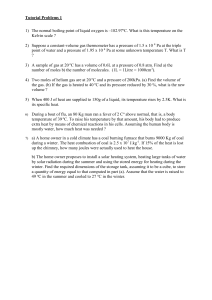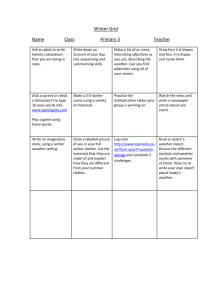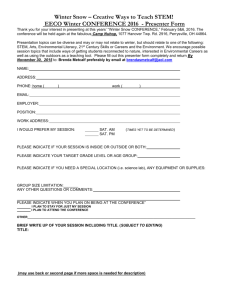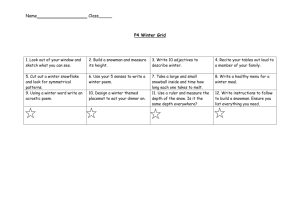Old Man Winter's Coming, Are You Ready?
advertisement
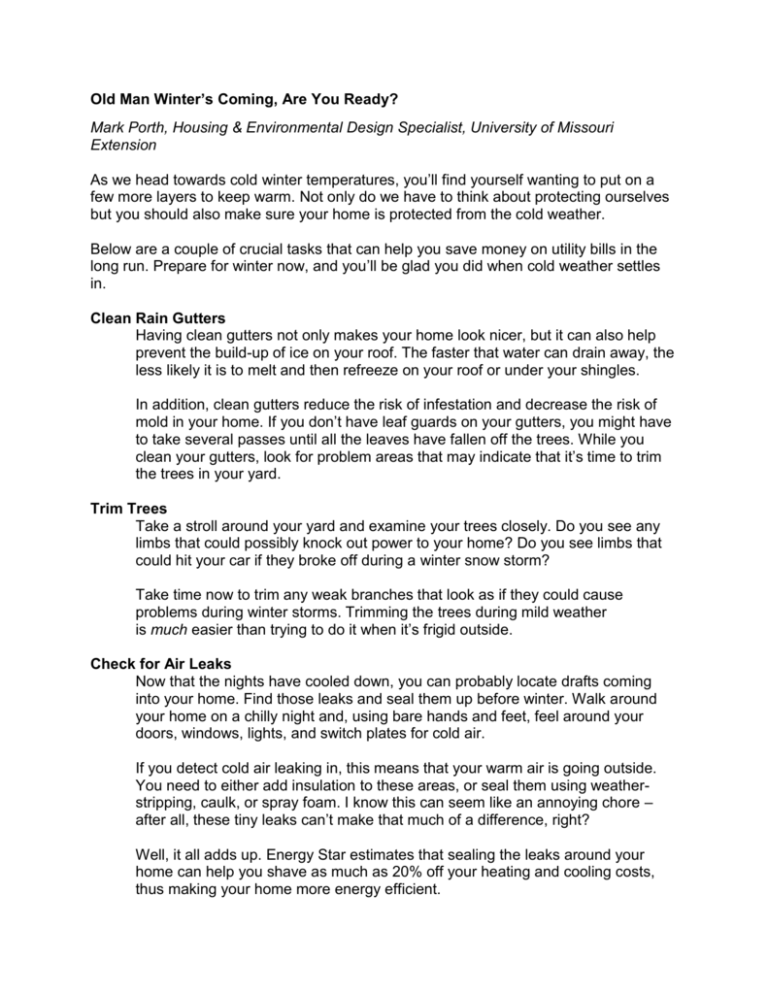
Old Man Winter’s Coming, Are You Ready? Mark Porth, Housing & Environmental Design Specialist, University of Missouri Extension As we head towards cold winter temperatures, you’ll find yourself wanting to put on a few more layers to keep warm. Not only do we have to think about protecting ourselves but you should also make sure your home is protected from the cold weather. Below are a couple of crucial tasks that can help you save money on utility bills in the long run. Prepare for winter now, and you’ll be glad you did when cold weather settles in. Clean Rain Gutters Having clean gutters not only makes your home look nicer, but it can also help prevent the build-up of ice on your roof. The faster that water can drain away, the less likely it is to melt and then refreeze on your roof or under your shingles. In addition, clean gutters reduce the risk of infestation and decrease the risk of mold in your home. If you don’t have leaf guards on your gutters, you might have to take several passes until all the leaves have fallen off the trees. While you clean your gutters, look for problem areas that may indicate that it’s time to trim the trees in your yard. Trim Trees Take a stroll around your yard and examine your trees closely. Do you see any limbs that could possibly knock out power to your home? Do you see limbs that could hit your car if they broke off during a winter snow storm? Take time now to trim any weak branches that look as if they could cause problems during winter storms. Trimming the trees during mild weather is much easier than trying to do it when it’s frigid outside. Check for Air Leaks Now that the nights have cooled down, you can probably locate drafts coming into your home. Find those leaks and seal them up before winter. Walk around your home on a chilly night and, using bare hands and feet, feel around your doors, windows, lights, and switch plates for cold air. If you detect cold air leaking in, this means that your warm air is going outside. You need to either add insulation to these areas, or seal them using weatherstripping, caulk, or spray foam. I know this can seem like an annoying chore – after all, these tiny leaks can’t make that much of a difference, right? Well, it all adds up. Energy Star estimates that sealing the leaks around your home can help you shave as much as 20% off your heating and cooling costs, thus making your home more energy efficient. Check Your Furnace Filter Before you start running your furnace, check the filter – it may need to be replaced. If your furnace filter looks dirty, then definitely replace it. During the winter months, I change my furnace filter every 4 to 6 weeks. Having a clean filter helps your furnace run more efficiently, which can save you energy and money. A clean filter can save you 5% to 15% on your heating bill. Insulate Pipes and Hot Water Heater Have you insulated your water pipes and hot water heater? If you haven’t, this relatively easy project can help trim your water heating costs this winter, especially if your water pipes run through a chilly or unheated basement. According to the Department of Energy (DOE), insulating your hot water pipes can help raise the temperature 2 to 4 degrees. This can allow you to get piping hot water on a lower setting, saving you both energy and money. The DOE also states that insulating your hot water heater trims 4% to 9% off your water heating costs. Get Your Chimney Cleaned You probably haven’t used your fireplace since last winter. Before you use it on the first chilly night, you need to have your chimney cleaned by a professional. In addition to increasing the heating efficiency of your fireplace, an annual cleaning also helps to ensure your family’s safety during the winter months. Chimney fires, a build-up of deposits, and animals nesting in your chimney make it unsafe to use. Having the chimney cleaned every year helps to eliminate these risks for fire in your home. While the thought of preparing your home for winter makes most people groan, you can easily do most of these projects, and they’re more than worth the effort. In fact, not doing these projects means you’ll likely have to bundle up and take care of them after the snow starts flying, when the cold and wind can make the tasks that much more difficult and unpleasant to do. If you have a questions or would like more information on how to prepare your home for winter weather, visit extension.missouri.edu or contact Mark Porth, West Central Regional Housing & Environmental Design Specialist, at the Henry County Extension Office at (660) 885-5556 or porthm@umsystem.edu.


